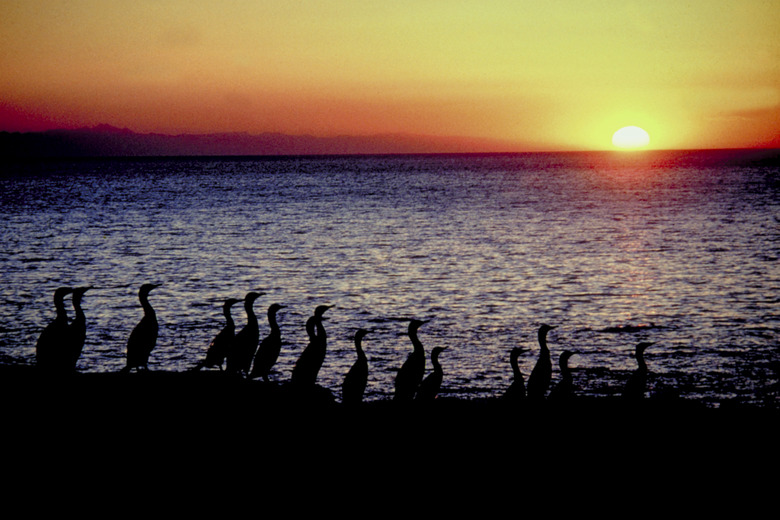Ecosystem Of A Shoreline
Shoreline and shore ecosystems happen where water meets land. Considering that water covers 75 percent of the planet, this area might appear extensive, but in reality, it comprises a narrow space. Despite this fact, much life occurs around shorelines, and the ecosystems that develop there teem with biodiversity.
Shorelines can be freshwater, saltwater or — where rivers meet the ocean — a mix of the two, which is called brackish water. Let's look a bit closer at some shoreline facts and about the ecosystems that exist there.
Ocean Shoreline Ecosystem
Ocean Shoreline Ecosystem
Perhaps the shoreline we're all most familiar with is the ocean shoreline we see at the beach. These ecosystems depend on the cycle of tides from high to low. Tidal pools are common in these ecosystems, which allows many aquatic animals to form special niche communities.
Birds like seagulls are also common as they hunt the fish in the shallow water. Shellfish and mollusks are also found in this ecosystem attached to rocks, docks, marinas and boats.
Freshwater Shore Ecosystem
Freshwater Shore Ecosystem
A freshwater shoreline, like the area directly surrounding a lake or a river, encompasses the shallow area near shore as well as the area on land adjoining the water. Plants form the basis of the ecosystem, and in the water, emergent plants dominate. Examples include water lilies, sedges, and arrow arum. These plants provide shelter and food to many different insects and small fish and also fertile hunting grounds for larger predators such as bass, pike, snapping turtles and wading birds.
On the shore, willows and other water-loving trees grow and provide shelter and nesting places for birds. Raccoons and other opportunist omnivores feed in the shallow water, consuming crustaceans, fish, mollusks, frogs and toads, and other shoreline animals and plants.
Estuary Ecosystems
Estuary Ecosystems
An estuary in an ecosystem and area where saltwater and freshwater mix in one area. These are often where the mouths of rivers meet ocean environments.
The ocean exerts a strong influence in brackish river estuary ecosystems. Estuaries run by the rhythm of the tides: when the tide comes in, the water will run upstream, and when it goes out, the water will run downstream.
Salt marshes, the main type of shoreline ecosystem in estuaries, serve as nurseries of the ocean and have some of the highest levels of biodiversity in the world. Salt-tolerant grasses such as cord grass form the basis of the ecosystem. They die in the winter and provide food for a multitude of saltwater and freshwater animals.
Dune Ecosystem
Dune Ecosystem
Sand dunes, one of the most common shoreline types, skirt the edges of oceans and large lakes in many locations around the world. Dunes form when wind blows sand inland, where plants such as beach grass or sea grape trap the sand and it begins to pile up, creating a hill or sand dune. Although dunes may look relatively empty, many species of plants and animals inhabit them.
Insects thrive in the dry grasses where birds and spadefoot toads prey upon them. Shorebirds such as plovers and killdeer nest in low dunes. Because of high winds and tides, dunes are not permanent structures but constantly shift, move and change shape.
Mangrove Ecosystem
Mangrove Ecosystem
Mangrove swamps, another of the more common ocean shoreline ecosystems, exist across the world in tropical or sub-tropical climates. Mangroves build up shoreline and protect inland areas from storm damage. The roots of mangrove trees trap mud, sand, dirt and floating debris, and fish and other ocean animals shelter in the tangled roots.
This attracts predators such as small sharks, crocodiles, pelicans and wading birds. As soil builds up, different mangroves take over, and eventually the area converts to land and the shoreline moves further into the ocean. Mangrove trees reproduce and spread by dropping large seeds into the water, where the current carries them to other locations.
References
- King County: Shoreline Ecology
- Missouri Botanical Gardens: Shorelines
- New York City Department of Parks and Recreation: Inwood Hill Park
- South Carolina Department of Natural Resources: Dynamics of the Salt Marsh
- New Hampshire Department of Environmental Services: What Is a Sand Dune
- Environmental Protection Agency: Mangrove Swamps
- National Ocean Service: What Is an Estuary?
Cite This Article
MLA
Dolph, Mara. "Ecosystem Of A Shoreline" sciencing.com, https://www.sciencing.com/ecosystem-shoreline-9237/. 31 July 2019.
APA
Dolph, Mara. (2019, July 31). Ecosystem Of A Shoreline. sciencing.com. Retrieved from https://www.sciencing.com/ecosystem-shoreline-9237/
Chicago
Dolph, Mara. Ecosystem Of A Shoreline last modified August 30, 2022. https://www.sciencing.com/ecosystem-shoreline-9237/
